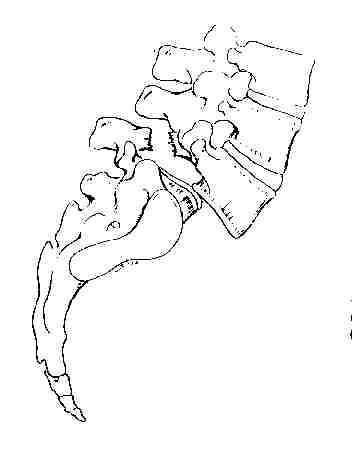JKW says that with spondylo, with the assisted exercise, the knees should be brought up as close to the chest as possible.
Iíve been playing with a new exercise technique, provisionally we could call it "Supine Dancing": lie on your back on the floor (on a rug), find the music that most gets your body moving, carefully shake your body. Explore what feel good, healing, for the problematic area. For instance, if low back pain is severe, rocking the shoulders might be soothing.
Catherine writes: I have been having problems with my legs due to spondylolithesis with spinal stenosis. I am 15, and have had to quit sport activities because of increasing numbness in my legs. I was wondering if you could tell me more about this disorder? I have had problems for two years, and I want to know if it will get quickly worse? I have had one opinion from an Orthopedic Surgeon and after two visits he strongly suggests fusion of the vertebrae through surgery. I would appreciate your feedback.
In this condition a vertebra (spondylo) slips forward.  This can happen when there is a brake, a fracture, in the posterior elements
of the vertebra, usually in the articular pillar (pars interarticullaris
- hence called a "pars defect"). Because the spondylolithesis causes a
distortion of the spinal canal it can cause a narrowing (stenosis) and
this can compromise the spinal cord or the spinal nerves. Six percent
of the population have sponylolithesis, but as often as not it is not
symptomatic! Twelve percent of gymnasts have spondylolithesis. It is thought
that the "pars defect" develops as the result of trauma in young people
before the skeleton has fully ossified, while there are still cartilaginous
segments (epiphyses) that allow for growth. Spondylos are graded: grade
1 less then 25% slippage, grade 2 less then 50%, etc.
This can happen when there is a brake, a fracture, in the posterior elements
of the vertebra, usually in the articular pillar (pars interarticullaris
- hence called a "pars defect"). Because the spondylolithesis causes a
distortion of the spinal canal it can cause a narrowing (stenosis) and
this can compromise the spinal cord or the spinal nerves. Six percent
of the population have sponylolithesis, but as often as not it is not
symptomatic! Twelve percent of gymnasts have spondylolithesis. It is thought
that the "pars defect" develops as the result of trauma in young people
before the skeleton has fully ossified, while there are still cartilaginous
segments (epiphyses) that allow for growth. Spondylos are graded: grade
1 less then 25% slippage, grade 2 less then 50%, etc.  A grade one, as we said, is often not symptomatic and would rarely call
for fusion. Higher grades might sometimes benefit from surgical stabilization.
Unfortunately I donít know any orthopods outside of Toronto to recommend
to you, but do seek more informed opinions and explore your options before
considering surgery. (You might even want to contact the Gonstead Clinic
in Mount Horeb, Wisconsin. I wrote about spondylolithesis and back pain
earlier to Colin. Take a look at those notes
as well.
A grade one, as we said, is often not symptomatic and would rarely call
for fusion. Higher grades might sometimes benefit from surgical stabilization.
Unfortunately I donít know any orthopods outside of Toronto to recommend
to you, but do seek more informed opinions and explore your options before
considering surgery. (You might even want to contact the Gonstead Clinic
in Mount Horeb, Wisconsin. I wrote about spondylolithesis and back pain
earlier to Colin. Take a look at those notes
as well.